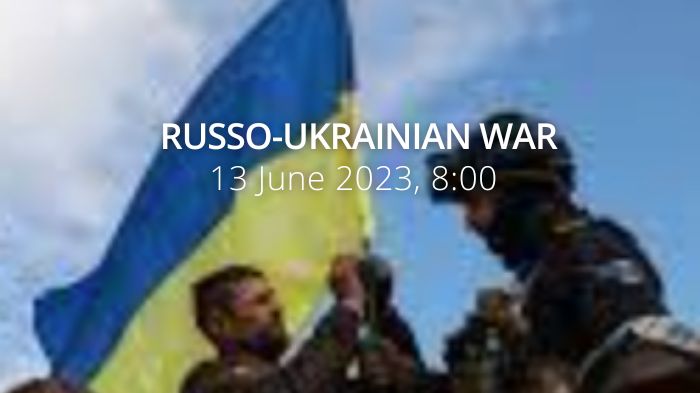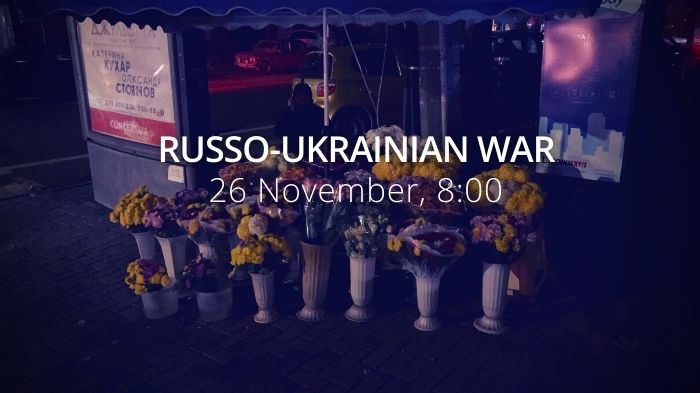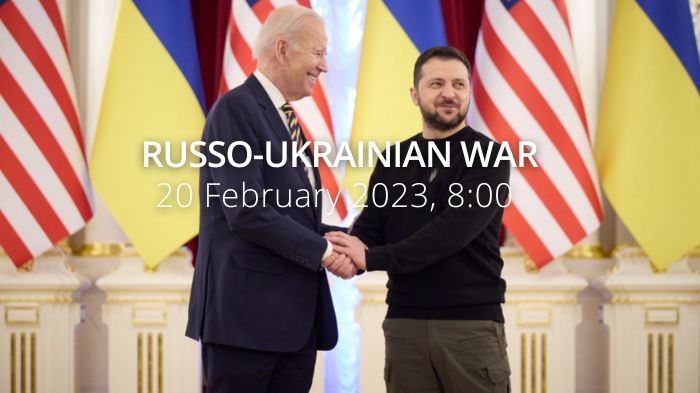Seven settlements liberated in the counteroffensive; Ukrainian forces continued counteroffensive operations in at least three directions and made further limited territorial gains. Putin believes Russia can outlast Western military support for Ukraine. Russian sources: A Ukrainian missile strike killed Chief of Staff of the 35th Combined Arms Army in Zaporizhzhia Oblast.
Daily overview — Summary report, June 14
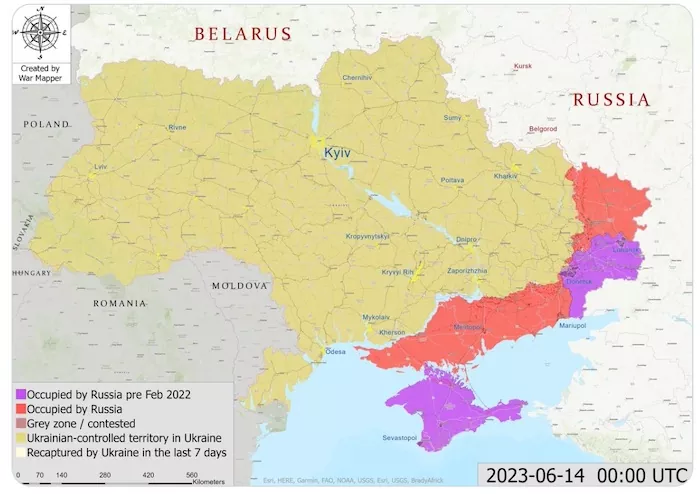
The General Staff’s operational update regarding the Russian invasion as of 18.00 pm, June 14, 2023 is in the dropdown menu below:
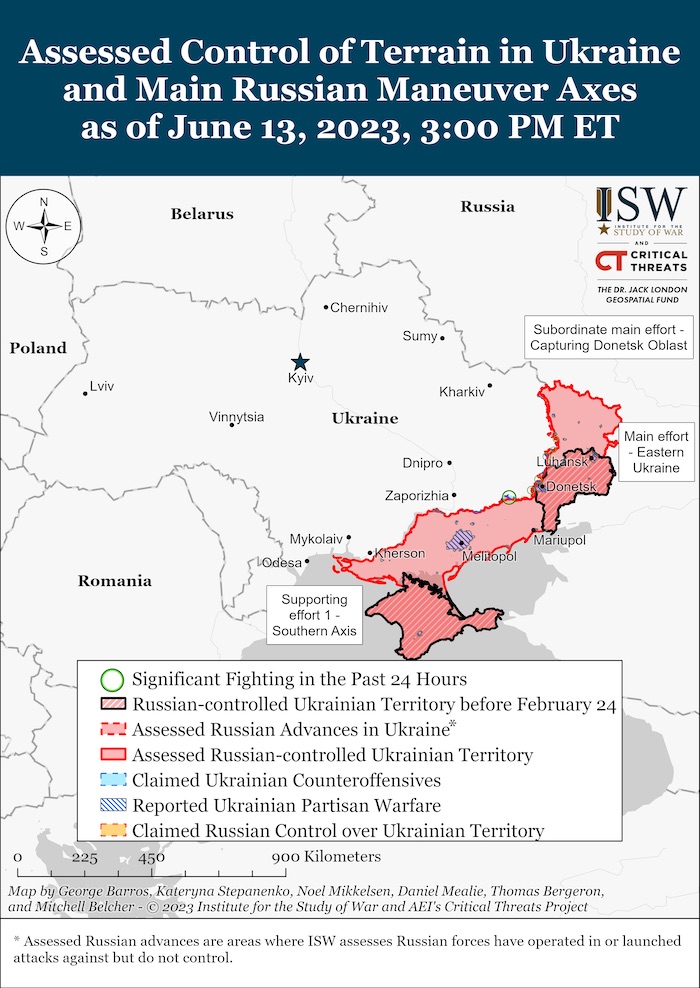
[The Russian Federation continues to wage a war of aggression. Despite significant losses, they do not give up plans to fully occupy Ukrainian territory.]
]The adversary continues to ignore the laws and customs of war, and uses terror tactics, strikes, and fires at both military and civilian targets.]
Tonight, the Russian invaders attacked the territory of Ukraine with cruise missiles and Iranian attack UAVs of the "Shahed" type. Information regarding the consequences of this attack is currently being clarified.
During the past day, the Russian invaders launched a missile and air strike, using 16 Kh-101/Kh-555 air-based cruise missiles and 4 Iranian attack UAVs "Shahed" on critical infrastructure facilities in the Kharkiv region and residential buildings in Kryvyi Rih. Our soldiers destroyed 11 cruise missiles and one attack drone. In addition, the enemy carried out 39 airstrikes and launched 62 MLRS attacks on the positions of our troops and populated areas.
[The threat of missile and air strikes remains high across Ukraine.
The enemy continues to focus its main efforts on the Lyman, Bakhmut, Avdiivka, and Mar’inka axes, and heavy fighting continues.] During the past day, 28 combat clashes took place on the indicated part of the front.
- Volyn’ and Polissya axes: the operational situation has not changed significantly.
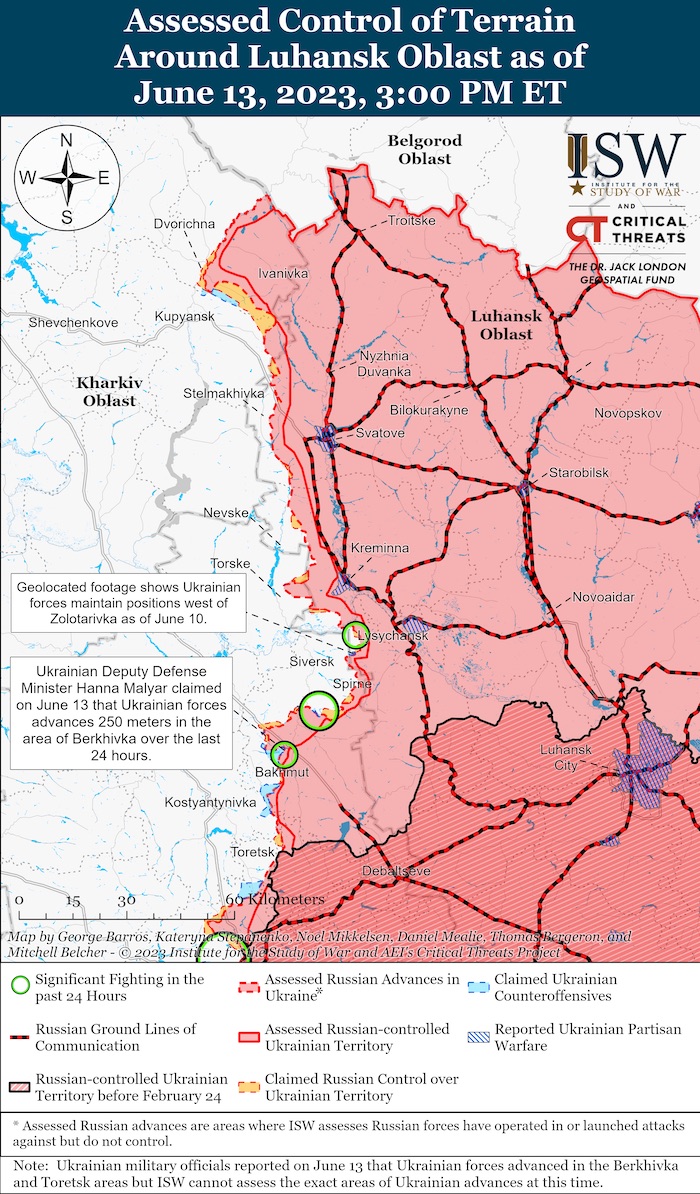
- Sivershchyna and Slobozhanshchyna axes: the enemy carried out an airstrike in the Ohirtsevo area of the Kharkiv region, carried out mortar and artillery attacks on the settlements of Karpovichi in the Chernihiv region; Novovasylivka, Stara Huta, Seredyna-Buda, Bachivsk, Atynske, Bilopylla, Pavlivka, Obody, Kindrativka, Myropilla of the Sumy region, as well as Ivashki, Udy, Strelecha, Lukyantsi, Izbytske, Staritsa, Synelnikove, Ohirtseve, Gatyshche, Vovchansk, Budarki and Vilkhuvatka in Kharkiv Oblast.
- Kupiansk axis: the enemy launched an airstrike in the Krokhmalnoye district of the Kharkiv region. Kamianka, Topoli, Novomlynsk, Dvorichna, Zapadne, Kupiansk, Kislivka, and Berestov in Kharkiv Oblast and Novoselivske in Luhansk Oblast were hit by artillery and mortar attacks.
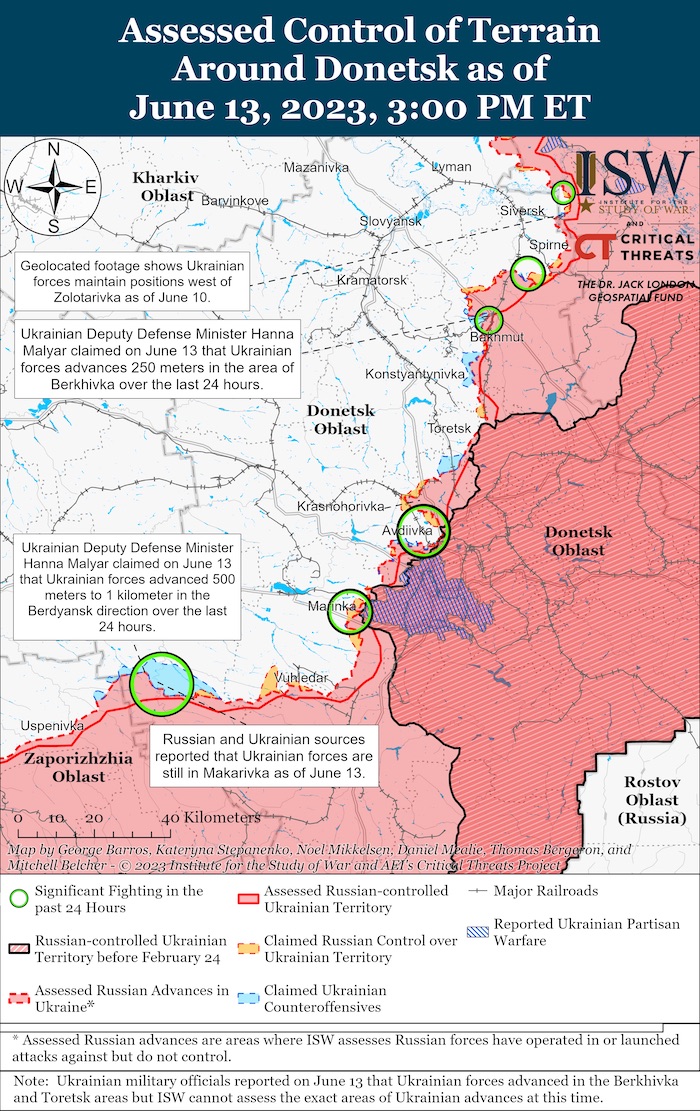
- Lyman axis: the enemy conducted unsuccessful offensive actions in the Vesely and Rozdolivka areas. He carried out airstrikes on the settlements of Bilogorivka of Luhansk and Vesele of Donetsk regions. Nevske and Bilogorivka in Luhansk Oblast and Yampolivka, Torske, Serebryanka, Verkhnokamianske and Spirne in Donetsk Oblast came under artillery shelling.
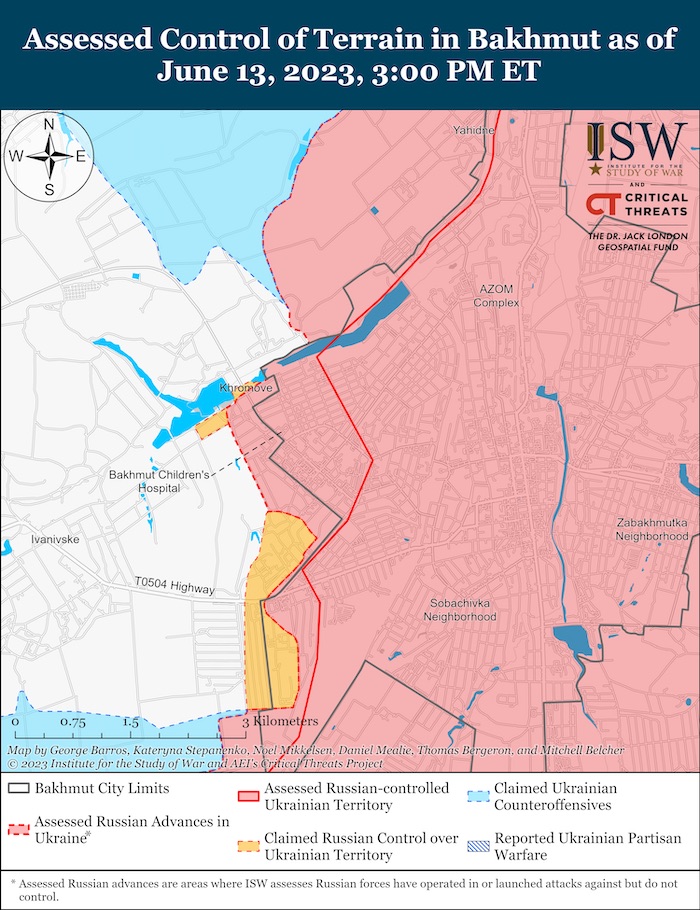
- Bakhmut axis: the enemy carried out unsuccessful offensive actions in the direction of Orihovo-Vasylivka, Ivanivskyi and Bila Hora. He carried out airstrikes in the areas of Hryhorivka, Toretsk and Sukha Balka settlements. Vasyukivka, Orihovo-Vasylivka, Hryhorivka, Bohdanivka, Ivanovske, Druzhba, Toretsk and Pivdenne of the Donetsk region were affected by enemy artillery shelling.
- Avdiivka axis: the enemy did not conduct offensive Carried out airstrikes near Avdiivka and Nevelskyi. He carried out artillery shelling of the regions of Avdiivka, Severne, Vodyane, Pervomaiske, Netaylove, and Karlivka settlements of the Donetsk region.
- Marinka axis: our defenders repelled all enemy attacks in the area of the city of Marinka, at the same time, the enemy launched an air strike within the population centre. He carried out artillery shelling of Krasnohorivka, Mariinka, Georgiivka, Maksimilianivka, Pobyeda and Novomykhailivka in the Donetsk region.
- Shakhtarske axis: the enemy launched an airstrike in the areas of Vugledar, Zolotaya Niva and Velika Novosilka. He shelled the settlements of Vugledar, Prechistivka, Zolota Niva, Shakhtarske, Velyka Novosilka, Storozhove, and Blagodatne of the Donetsk region.
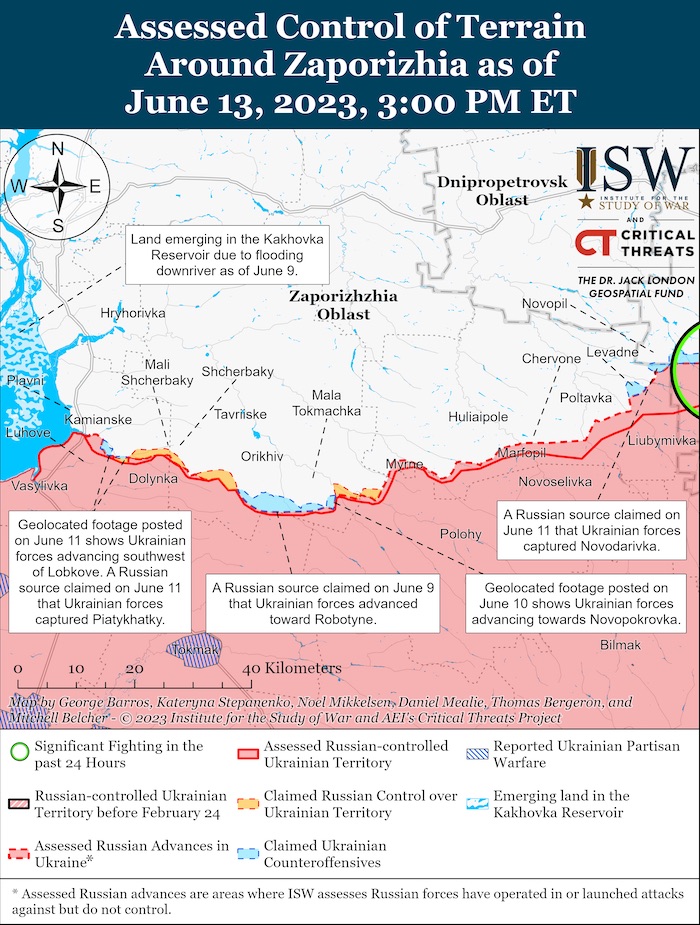
- Zaporizhzhia and Kherson axes: the enemy continues to conduct defensive He carried out an airstrike in the region of Malaya Tokmachka, Zaporizhzhia region. Shelled such settlements as Vremivka, Novopil of the Donetsk region; Levadne, Gulyaipole, Zaliznychne, Gulyaipilske, Zherebyanky, Kamianske of the Zaporizhzhia region; Zmiivka, Kozatske, Mykolaivka, Virivka, Inzhenerne, Zelenivka, Antonivka, Bilozerka, Dniprovske, Kizomys of the Kherson region and the city of Kherson.
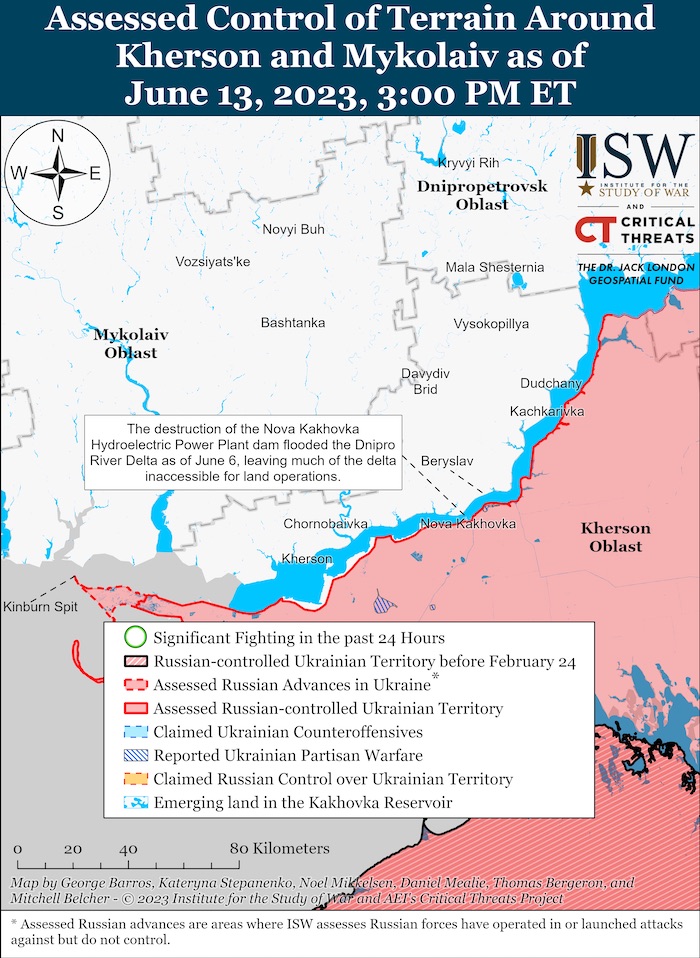
In the Zaporizhzhia region, the Russian occupiers continue to rob the local population, using military trucks to transport the looted property. Thus, from the village of Ocheretuvate, in the direction of the city of Tokmak, the movement of Russian motor convoys with looted household appliances, furniture and other property of local residents was recorded.
At the same time, at the berths of the seaport of the city of Berdiansk, cargo ships are being filled with grain crops stolen from Ukrainian farmers. In the future, the occupiers plan to export grain to the territory of the Russian Federation.
]In the flooded Holaya Prystan’, the occupiers are still present, while firing at evacuation points and shifting the blame on the Ukrainian Armed Forces for this. In turn, the occupation authorities force the local population to say on camera words of gratitude to the units of the Ministry of Emergency Situations of the Russian Federation for the supposed rescue and evacuation, although all this time, without any help from the occupation authorities, people were forced to save each other on their own. After the situation stabilized and the water receded, people returned to the city and witnessed looting and robbery of their own homes.]
During the day, the Ukrainian Air Force made 13 strikes on enemy personnel concentration areas and 4 strikes on enemy anti-aircraft missile complexes.
Also, our defenders destroyed 2 enemy UAVs of operational-tactical level "Orlan-10".
During the day, units of missile forces and artillery hit the command post, 8 areas of concentration of enemy personnel, weapons and military equipment, 3 ammunition depots, an anti-aircraft missile complex, 7 artillery units in firing positions, 2 anti-aircraft defence facilities and the enemy's electronic warfare station.“
On the night of June 14, 2023, the Russian invaders launched a missile attack on the military and infrastructure facilities of Ukraine with air and sea-based cruise missiles, as well as kamikaze attack drones, the Ukrainian General Staff reports. “The enemy launched four Kalibr cruise missiles in the direction of Odesa from the Black Sea. Three missiles were shot down, one hit a civilian object. From the eastern coast of the Sea of Azov, the Rashists attacked with 10 Iranian attack drones of the "Shahed" type in the southeast direction. Nine UAVs were shot down.
The invaders launched six Kh-22 air-launched cruise missiles from four Tu-22M3 long-range bombers from the Rostov region. Donetsk region was hit. The consequences are clarified.
In total, [the Ukrainian Armed Forces] destroyed 12 air targets during this night attack: three "Kalibr" cruise missiles and nine "Shahed" Iranian attack drones.
Military Updates
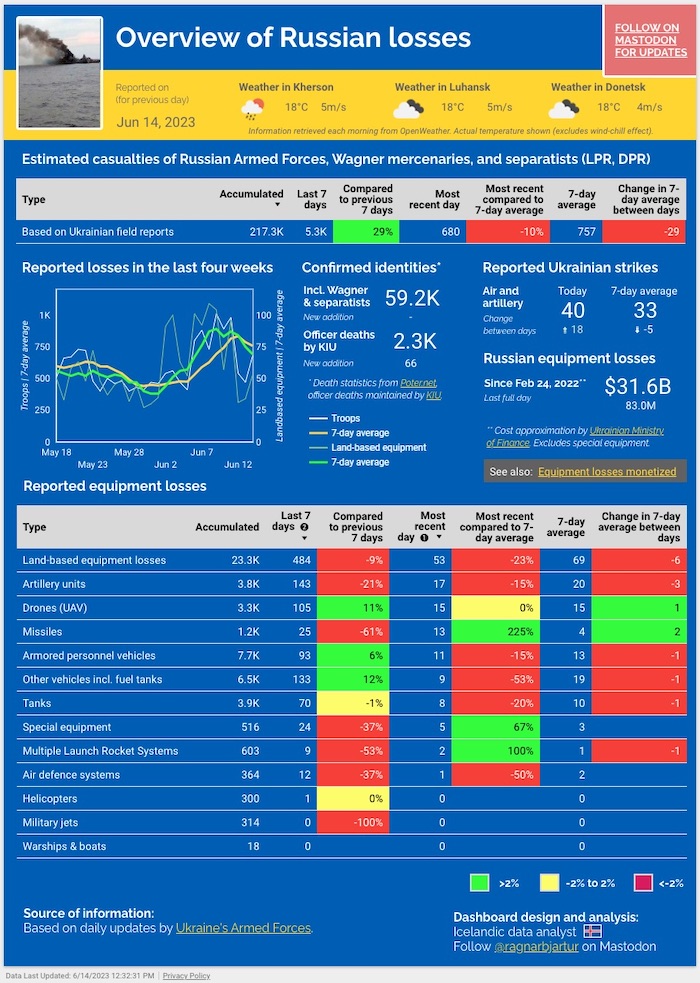
7 settlements have been liberated in the counteroffensive, Ukrainska Pravda reported Monday. reports, citing Hanna Maliar, Deputy Minister of Defence- “According to Maliar, Ukraine’s Defence Forces have liberated the settlements of Lobkove, Levadne, Novodarivka, Neskuchne, Storozhove, Makarivka and Blahodatne. She added that the group of offensive troops has advanced a total of 6.5 km, and the area of territory that Ukraine has taken back under its control is 90 square kilometres.”
Battlefield situation dynamic in terms of defence and offence, Ukrinform reports, citing Ukraine's Deputy Minister of Defense Hanna Maliar. “As of now, offensive actions continue in several areas. At the same time, we also have defensive actions, since the enemy is also advancing in several areas. Therefore, the situation is dynamic. Where we are advancing is the Bakhmut area, and everyone knows that the east is the epicentre of hostilities. At the same time, fierce fighting is taking place there, and one must understand that the enemy does not simply surrender the positions they once occupied, so these are very difficult battles, Maliar said.
She said there were also other factors that affect the situation, including the weather. If we talk about the weather now, it really complicates some things. In addition, the enemies have increased artillery and mortar shelling. That is, they are trying to slow the movement of our forces with shelling and are taking other measures, Maliar said. According to her, in the southern operational area, Ukraine's defence forces are faced with dense mining of fields, anti-tank ditches and constant counterattacks by enemy forces who massively use ATGMs and kamikaze drones.
In some areas we are advancing, while in other areas, if we talk about the Lyman area or Avdiivka, Marinka, the enemy is trying to counterattack and advance there, but they are not succeeding. Therefore, now the situation is dynamic and active both from the point of view of defence and from the point of view of offence, Maliar said.
When asked about the transfer of Russian troops from one area to another, she noted that Russian troops move constantly, but it is about replacing one unit with another, and not about changing troop numbers. At the same time, the enemy increases the number of shelling attacks at this time. When they move, their offensive actions slow, and they compensate for this by increasing the intensity of shelling and air strikes. They do this in all directions, where they both defend and attack, she said.”
According to British Defence Intelligence, (last 48 hours):
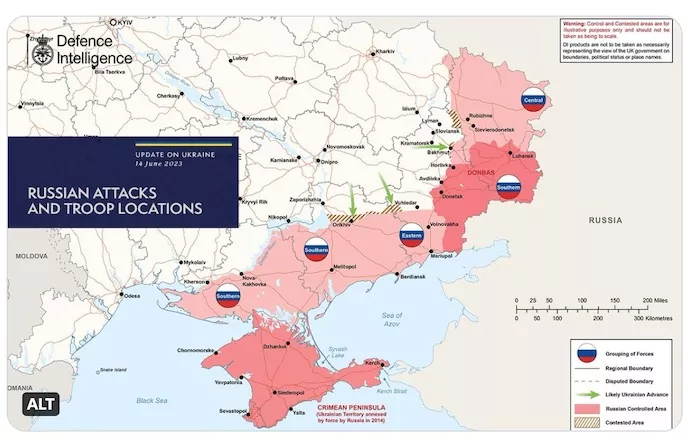
- In the last two weeks, there has been an uptick in Russian tactical combat air sorties, especially over southern Ukraine. This has almost certainly been in response to reports of increased Ukrainian offensive operations, as the Russian Aerospace Forces (VKS) attempt to support ground troops with air strikes.
- Despite the uptick, VKS’ daily sortie rate remains much lower than the peak of up to 300 daily missions early in the war.
- Since the start of the invasion, the south of Ukraine has often been more permissible for Russian air operations compared to other sectors of the front. Over the last year, VKS has increased its use of air-to-surface weapons, such as glide bombs, which allow attack aircraft to remain well away from their targets.
- In recent months, Russia has highly likely worked to ensure its long-term, high-volume supply of one-way-attack uncrewed aerial vehicles (OWA-UAVs). By supplying these weapons, Iran continues to breach UN Security Council Resolution 2231.
- Russia has likely moved from receiving small deliveries of Iranian OWA-UAVs by air transport, to larger consignments by ship from Iran via the Caspian Sea. This ‘International North-South Transit Corridor’ has assumed much more importance since the invasion. It allows Russia to access Asian markets - including arms transfers - in ways it hopes are less vulnerable to international sanctions.
- Russia is also working to start domestic production of OWA-UAVs, almost certainly with Iranian assistance. Russia is highly likely investing in OWA-UAVs because it provides Russia with a relatively cheap long-range strike capability at a time when it has expended a large proportion of its cruise missile stocks in Ukraine.
Losses of the Russian army
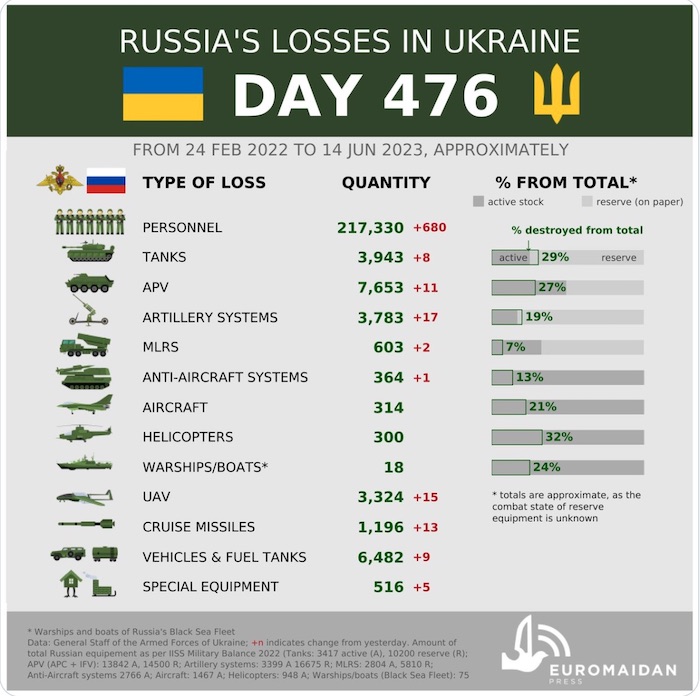
As of Wednesday 14 June, the approximate losses of weapons and military equipment of the Russian Armed Forces from the beginning of the invasion to the present day:
- Personnel – about 217330 (+680)
- Tanks – 3943 (+8)
- Armoured combat vehicles – 7653 (+11)
- Artillery systems – 3783 (+17)
- Multiple rocket launchers –MLRS - 603 (+2)
- Air defence means – 364 (+1)
- Aircraft - 314 (+0)
- Helicopters - 300 (+0)
- Automotive technology and fuel tanks – 6482 (+9)
- Vessels/boats - 18 (+0)
- UAV operational and tactical level – 3324 (+15)
- Special equipment – 516 (+5)
- Mobile SRBM system – 4 (+0)
- Cruise missiles – 1196 (+13)
Russian mercenary chief says unsure if his men will continue fighting in Ukraine, Reuters reports. “The head of Russia's powerful mercenary Wagner Group said on Tuesday he was not sure if his men would continue to fight in Ukraine amid a bitter standoff with the Defence Ministry after capturing the Ukrainian city of Bakhmut. It was unclear how serious Yevgeny Prigozhin was being as his fighters have proved themselves to be among Russia's most effective in Ukraine despite suffering huge losses, while any attempt by him to disengage from the war could be seen as treasonous by officials in Moscow.
Regarding the further work of the Wagner private military company in Ukraine, I am not sure that we will work specifically in Ukraine, Prigozhin said in reply to a Danish media query. Wagner fighters have also fought in Africa and the Middle East, where they still have some contracts. After spearheading the months-long battle for the eastern city of Bakhmut in which tens of thousands perished, Prigozhin last month withdrew his men to rest and regroup.”
Russians deploy coastal missile systems to Bryansk Oblast to launch attacks on Ukraine, Ukrainska Pravda reports, citing the National Resistance Center of Ukraine. “The Ukrainian resistance reports that the Russians have transferred the Bal coastal missile systems to Bryansk Oblast in Russia in order to launch attacks on the Ukrainian cities. This system is a part of the 11th Separate Coastal Rocket and Artillery Brigade of the Coastal Troops of the Black Sea Fleet. Its permanent location point is in the settlement of Utash in Krasnodar Krai in Russia.
The division targets ships. Due to the lack of corresponding missiles, Bal was equalised in range and the capacity to attack ground targets with the Bastion coastal missile system, which uses Oniks supersonic missiles. For this purpose, the system is armed with Kh-35/35U missiles, which were provided with new features after modernization in 2021 – their effective range was increased from 260 to 500 km."
Ukrainian defenders destroy Russian Solntsepyok system in Zaporizhzhia direction, Ukrinform reports. “The members of the National Guard and the Armed Forces of Ukraine destroyed an enemy TOS-1A Solntsepyok flamethrower system which was operating in Zaporizhzhia direction.
Aerial reconnaissance fighters of the Howitzer artillery division of the 3rd Spartan operational brigade spotted an enemy TOS-1A Solntsepyok flamethrower system and adjusted the artillery fire of the 47th Mahura Separate Mechanized Brigade on it. The successful actions of the soldiers of the National Guard and the Armed Forces of Ukraine led to the destruction of the heavy flamethrower system," the press service of the National Guard of Ukraine reports.”
Humanitarian
Due to blowing up Kakhovka HPP, food prices may rise, - UN, Censor.net reports, citing UN Under-Secretary-General for Humanitarian Affairs and Emergency Relief Coordinator Martin Griffiths, with reference to Radio Svoboda. “The destruction of the Kakhovka HPP will have a huge impact on global food security, causing food prices to rise and water supply problems for hundreds of thousands of people. This granary - this entire territory that goes down to the Black Sea and Crimea - is a granary not only for Ukraine but also for the world. We already have difficulties with food security, but food prices, I am sure, will definitely increase. It's almost inevitable that we're going to see huge problems with harvesting and planting the next crop. And so what we're going to see is a huge impact on global food security, he explained.
Griffiths also noted that the damage caused on such a scale to civilian infrastructure is completely contrary to international humanitarian law. It's obvious. Whoever did it violated the Geneva Conventions, Griffiths said. […] The fields in the south of Ukraine may turn into a desert. […]
In the Kherson region, as a result of Russian troops blowing up the Kakhovka HPP dam, the territories of the Nizhnyodniprovsky National Nature Park were flooded. In the occupied territories, in the first days, the evacuation of the population completely failed, the Ruscists did not allow volunteers to rescue people.
The Ministry of Health urges not to consume fish that died due to a drop in the water level as a result of the Russians blowing up the dam of the Kakhovskaya HPP. There is no safe way to prepare it. As of the morning of June 8, 600 square kilometers have already been flooded in the Kherson region. The most difficult situation is on the left bank of the Dnieper.
The head of the Ministry of Foreign Affairs of Ukraine, Dmytro Kuleba, and the coordinator of the UN system in Ukraine, Denise Brown, agreed that the organization will immediately form groups to provide humanitarian aid and evacuate people in the occupied territories on the left bank of the Dnipro, provided that Russia provides access and security guarantees. Ukrhydroenergo predicts that the flood in the Kherson region will last for about another two weeks. Only in mid-July, the Dnipro will withdraw from the flooded settlements in the south of the country.
The World Health Organization (WHO) warns of an increase in the threat of an outbreak in Ukraine due to the explosion of the Kakhovskaya HPP of several infectious diseases, including cholera and other water-borne diseases.”
Environmental
UN nuclear chief's visit to Zaporizhzhia nuclear plant delayed, Reuters reports. “A planned visit by UN nuclear chief Rafael Grossi to Ukraine's Russian-held Zaporizhzhia nuclear power plant has been delayed by some hours, a diplomatic source said on Wednesday. The source did not make clear when Grossi would arrive at the plant. Russian state-owned news agency RIA said the visit had been expected to take place on Wednesday but that it had been delayed by a day. […]
The IAEA said on Sunday it needed access to a site near the Zaporizhzhia plant to check water levels after the nearby reservoir lost much of its water because of the destruction of the Kakhovka dam downstream.”
Russians blow up dams in territories where Ukrainian counter-offensive continues - Ministry of Defense, Censor.net reports, citing Suspilne and the representative of the Department of Environmental Security and Mine Action of the Ministry of Defense of Ukraine, Major Vladyslav Dudar. “The Russian military is blowing up hydraulic structures in the territories where the Defense Forces of Ukraine are counterattacking. According to him, Russian troops mined a large number of hydro-technical structures in the Zaporizhzhia and Kherson regions.
They blow up small hydro-technical structures in various settlements every day, said Dudar. He noted that the consequences of these actions are not large-scale yet - each such detonation affects the agricultural lands of one or two villages, but this happens regularly.”
Area of Kakhovka reservoir decreased by 50%, Censor.net reports. “As of June 12, the reservoir has decreased by 50%. There is 60-70% less water in the Kakhovka reservoir than before the explosion. General Director of "Ukrhydroenergo" Ihor Syrota said. He also emphasized that there will be serious consequences for the environment if the water in the reservoir falls below the critical level - about 3 meters.
We hope that the lower hydro-technical structure has remained intact. If so, the level of the Kakhovka reservoir may remain within 6-7 meters. If it is damaged, the water level will drop below the critical level, Syrota said.”
Blowing up of Kakhovka HPP: Institute of Protection of Soil expects migration of heavy metals with dust, Ukrainska Pravda reports, citing Roman Palamarchuk, deputy head of the Institute of Protection of Soil. “As a result of the draining of the Kakhovka reservoir, wind erosions may occur on its territory, which may cause the migration of heavy metals with dust. After the irrigation of the flooded soil stops, the migration of salts to upper [soil – ed.] horizons will start, and it will pose a threat to ecology in the future.
As for the territory of the Kakhovka reservoir, which will soon be basically dried up, wind erosion will occur there, which will cause the migration of heavy metals with dust, Palamarchuk forecasted. Yet these forecasts so far are not precise and the scale of the disaster is impossible to predict. For instance, there is no information at all coming from the Russian-occupied left bank of the Dnipro River in Kherson Oblast.”
Destruction of Kakhovka HPP caused over US$4 billion worth of damage to Ukrainian agricultural water management systems, Ukrainska Pravda reports, citing the press service of the Ministry of Agriculture and Food of Ukraine. “State-owned agricultural water management systems and canals were damaged as a result of the explosion on the Kakhovka Hydroelectric Power Plant (HPP), the losses reached UAH 150-160 billion [approx. US$4,3 billion – ed.], but the exact data will be determined after the liberation of the territories.
After the explosion on the Kakhovka HPP, the agency presumes that water management systems will be destroyed or dismantled by the Russian forces. Without the restoration of the water supply source, it is impossible to talk about irrigated agriculture in southern Ukraine in the near future, the report said.
The Ministry of Agrarian Policy and Food of Ukraine recalled that the Kakhovka reservoir was a source of irrigation for 94% of the systems in Kherson, 74% in Zaporizhzhia and 30% in Dnipropetrovsk oblasts. The Kakhovka reservoir was a source of water supply for 584,000 hectares of land, to which water was supplied for irrigation. In particular, the Kakhovka main canal served 326,000 hectares of land, while the North Crimean canal was crucial for 39,700 hectares of agricultural land.
In addition, a number of systems in Zaporizhzhia, Kherson and Dnipropetrovsk Oblast carried out a separate water intake from the Kakhovka reservoir for a total irrigation area of 218,300 hectares. Even before the occupation of the Kakhovka HPP, almost 5 million hectares of agricultural land in Ukraine needed restoration of water management systems, which would have required about US$15 billion of investment.”
Destruction of Kakhovka Hydroelectric Power Plant: Crimea will not receive water for at least a year, Ukrainska Pravda reports, citing Ihor Syrota, Ukrhydroenergo CEO. "There is no water supply to Crimea because the water level in the Kakhovka reservoir is much lower than the water level required to flow through the Crimean Canal. Therefore, most likely, water will not be supplied to Crimea for at least a year.
Given we are liberated, we will not be able to provide them with water at first either. Dnipropetrovsk, Zaporizhzhia, Kherson and Mykolaiv oblasts will suffer from water supply problems. We roughly understand that these are the four oblasts that will suffer from water supply problems. Because we know that water intakes no longer work below 12.70 metres (we called this the ‘dead zone’)."
According to him, alternative solutions are now being considered to firstly provide the population with drinking water. There are no problems [with the supply of drinking water – ed.] yet. As far as we know, Kryvyi Rih has reserves for 1.5-2 months. Nikopol and other cities that are suffering from flooding are receiving water. The prime minister instructed us to quickly increase the number of wells in Kherson, Mykolaiv and Dnipropetrovsk oblasts.
Firstly near hospitals to provide people with drinking water. Where this is not possible, drinking water will be delivered. And then we will work to produce industrial water."
Support
Training of Ukrainian pilots on F-16 fighter jets to start this summer – Dutch Defence Minister, Ukrainska Pravda reports, citing Reuters. “Kajsa Ollongren, Minister of Defence of the Netherlands, believes that Ukrainian pilots could begin training on US F-16 fighter jets as early as this summer. […] [The start of the training – ed.] this summer is our ambition. And we'll see if that's realistic, Ollongren said.
Two anonymous sources informed Reuters that the training will begin with two 12-person groups of Ukrainian pilots who already have experience of flying Soviet MiG fighter jets. Ollongren added that the fighter jet coalition aims to organise the F-16 fighter jet training programme for Ukrainian pilots during the next six months. Denmark will likely be chosen as the location for the training, as it has the necessary flight simulators.
Ollongren says Belgium and Luxembourg will join the training programme, and France and the UK have offered their help. The Netherlands have yet to make a final decision concerning Kyiv’s request for F-16 fighter jets. At the same time, F-16s will bring Ukraine closer to NATO military potential, which is very important for the future. […] It's not going to be available anytime soon and President [Volodymyr] Zelenskyy, of course, knows that the minister stated.
Usually it takes about 2.5 years to become a fighter pilot in the Netherlands. But an anonymous US official told Reuters that the basic F-16 training could take only four months for an experienced Ukrainian pilot.”
Biden administration announces additional security assistance for Ukraine, US Department of Defense states. “Today, the Department of Defense (DoD) announced additional security assistance to meet Ukraine’s critical security and defense needs. This authorization is the Biden Administration’s fortieth drawdown of equipment from DoD inventories for Ukraine since August 2021. It includes key capabilities to aid Ukraine’s efforts to retake its sovereign territory and support Ukraine’s air defenders as they bravely protect Ukraine’s soldiers, civilians, and critical infrastructure, as well as artillery, anti-armor systems, and ammunition valued at up to $325 million.
The capabilities in this package include: Additional munitions for National Advanced Surface-to-Air Missile Systems (NASAMS); Stinger anti-aircraft systems; Additional ammunition for High Mobility Artillery Rocket Systems (HIMARS); 155mm and 105mm artillery rounds; 15 Bradley Infantry Fighting Vehicles; 10 Stryker Armored Personnel Carriers; Javelin anti-armor systems; Tube-Launched, Optically-Tracked, Wire-Guided (TOW) missiles; AT-4 anti-armor systems; Over 22 million rounds of small arms ammunition and grenades; Demolition munitions for obstacle clearing; Tactical secure communications support equipment; Spare parts and other field equipment.
The United States will continue to work with its Allies and partners to provide Ukraine with capabilities to meet its immediate battlefield needs and longer-term security assistance requirements.”
Allies to deliver air defence equipment to Ukraine worth 107 million euros, Ukrainska Pravda reports, citing Ben Wallace, Secretary of State for Defence of the United Kingdom, at the meeting of heads of the defence departments of the countries participating in the Joint Expeditionary Force (JEF). “On Tuesday, the United Kingdom announced a new GBP 92 million (EUR 107.5 million) military aid package for Ukraine to strengthen air defences. The military aid will be procured through the British-led International Fund for Ukraine (IFU) with the goal of strengthening Ukraine's ability to protect critical national infrastructure, civilians and front-line military personnel. As part of the package, Kyiv will receive radars to protect against indiscriminate Russian strikes, as well as cannons and a significant amount of ammunition.
The UK has contributed a further £250 million to the International Fund for Ukraine and, with allies and partners, through the fund we are providing a package of air defence to help Ukraine protect their critical national infrastructure and defend against indiscriminate Russian air strikes, Wallace emphasised.
The IFU uses financial contributions from international partners to procure priority military assistance for Ukraine. More than GBP 520 million (EUR 607,8 million) has been raised through the IFU following contributions from the UK, Norway, Netherlands, Denmark, Sweden, Iceland and Lithuania.”
Ukraine asks Germany to send more Leopards and Marders, Euromaidan Press reports. “As Ukraine intensifies its counter-offensive against the Russian invasion in the country’s south and east, Deputy Foreign Minister Andriy Melnyk is appealing for more German-made Leopard 2 tanks, n-tv reports. This call comes in the wake of initial losses in the conflict. Experts from Germany’s FDP and CDU political parties are expressing support for this request.
Melnyk was quoted in Berlin’s Tagesspiegel: “The Ukrainian army most urgently needs many more Western battle tanks, infantry fighting vehicles and other armored vehicles.” Noting the value of the Leopard 2 tanks in the ongoing offensive, the former Ukrainian ambassador in Berlin underscored that the German military could increase its provision beyond the already delivered 18 units from a pool of more than 300 without compromising Germany’s defense capabilities. Melnyk suggested the number could be tripled.
Additionally, Melnyk requested that the Ukrainian army be granted “another 60 Marder infantry fighting vehicles.” […] Supporting Melnyk’s request, CDU security policy maker Roderich Kiesewetter told Tagesspiegel that supporters should immediately replace all destroyed material – including Leopard battle tanks and infantry fighting vehicles – and supply additional material. […]
Melnyk also reiterated the demand for Germany to provide Taurus cruise missiles and assist in building a robust Ukrainian air force. Ukraine is “waiting for Germany’s strategic decision to actively participate in the fighter jet coalition, to immediately enable the training of Ukrainian pilots on Eurofighters and to contribute a part of over 130 aircraft, said Melnyk.”
We are not able to replace every tank lost in Ukraine – German Defence Minister, Ukrainska Pravda reports, citing NTV. “Against the background of the latest reports about destroyed Leopard 2 tanks in Ukraine, German Defence Minister Boris Pistorius has promised to supply more of these tanks.
We will not be able to replace every tank that is now out of service. But what we are doing (...) is that we will continue to supply more refurbished Leopard 1 A5 tanks from July onward. And there will be over 100 [tanks – ed.] by the end of the year," he said. […]
At the same time, Pistorius rejected calls for the supply of German Eurofighter Typhoon fighters to Ukraine, At the moment, this is not an issue because Ukraine primarily needs F-16 fighters. In addition, Pistorius said that the Bundeswehr depends on the Eurofighter to ensure its own defence capability. In the end, many different systems also do not help Ukraine because behind each aircraft there has to be special training, special logistics and special repairs, he noted.”
Denmark is sending additional ammunition to Ukraine; details are not disclosed, Ukrainska Pravda reports, citing Politiken. “Acting Danish Defence Minister Troels Lund Poulsen and Foreign Minister Lars Løkke Rasmussen on Monday announced an additional shipment of ammunition to Ukraine amid a full-scale Russian invasion. The Danish ministers did not disclose the details of the new military aid to Ukraine but clarified that it is about a quarter of a billion Danish crowns (33.5 million euros) worth of ammunition, including 2,000 artillery shells.”
NATO countries in Vilnius promise to increase military assistance to Ukraine – Jens Stoltenberg, Ukrainska Pravda reports, citing Jens Stoltenberg, NATO Secretary General, in an interview with the TV channel PBS. “First and foremost, the most important thing that will happen at the NATO summit in Vilnius in July is that NATO allies will express strong support to Ukraine, not only words, but also in deeds, because I'm absolutely certain that our NATO allies will make new announcements of significant military support to Ukraine and to promise to sustain and step that up, he said. According to the NATO Secretary General in Vilnius, the alliance members will support Ukraine for as long as necessary.
Speaking about the possibility of Ukraine's membership in NATO, Stoltenberg noted that consultations are continuing among the allies. It's too early to preempt the concrete outcome, but allies agree on a lot. We agree that NATO's door is open, as we have demonstrated with Finland and Sweden for new members, he added. At the same time, as the NATO Secretary General stressed, it's not possible to give precise dates when we are in the midst of a war.”
Duda openly supported Ukraine’s accession to NATO, Scholz and Macron were more cautious, Censor.net reports, citing the Tagesschau publication. “At the meeting of the heads of state and government of Poland, France, and Germany, President Andrzej Duda called for Ukraine to join NATO, the leaders of France and Germany preferred to talk about security guarantees. Polish President Andrzej Duda appealed to NATO member states to include Ukraine in the transatlantic defense alliance as soon as possible: Ukraine is waiting for a clear signal, a clear prospect of joining. Duda expressed hope that the upcoming NATO summit in Vilnius in mid-July will bring the light at the end of the tunnel that Ukraine so longs for.
French President Emmanuel Macron and Chancellor Olaf Scholz were more cautious. Scholz assured that they want to continue closely coordinating the issue of security guarantees for Ukraine. According to Scholz, Germany, and France, as well as American allies, have repeatedly sought dialogue to prepare for such a step. […] It is clear that security guarantees are needed in a very specific form, Scholz added.
The French president said that at the next meeting of the European Council, as well as at the NATO summit in Vilnius, what the future of collective security can look like will be discussed. Macron and Scholz assured that they want to support Ukraine as long as it is necessary, and NATO will provide Ukraine with all the support to which it is entitled.”
New Latvian president: obstacle to Ukraine's NATO membership is not Hungary, Ukrainska Pravda reports. “Edgars Rinkevičs, the Minister of Foreign Affairs and President-elect of Latvia, believes that the main obstacle on Ukraine's path to NATO is not Hungary: it is the uncertainty over the position of a wider range of countries. Rinkevičs noted that the main obstacle to Ukraine's accession to the North Atlantic Alliance is the internal debate within NATO, not Ukraine itself or Russia's unspoken "veto".
The reason is that now, in many capitals of NATO member states, there is not a clear enough understanding of what to do in a situation where a state at war joins the Alliance, and what this means in the context of Article 5. Let me be clear: this is the main question. And this is precisely the question many member states cannot give an answer to. And until they have this answer for themselves, they will not be able to answer at the same table and with other NATO members. […] Rinkevičs noted that Latvia sees Ukraine's future in NATO and for its part will do everything possible to make it happen.”
New Developments
- Russia's Medvedev says Moscow now has free hand to destroy enemies' undersea communications cables, Reuters “Former Russian President Dmitry Medvedev said on Wednesday there were no longer any "moral limits" to stop Moscow from destroying its enemies' undersea communication cables given what he [alleged] was Western complicity in the Nord Stream pipeline blasts.”
- Ukraine's Ambassador reveals US conditions for transfer of ATACMS missiles, Ukrainska Pravda reports, citing The Page. “Oksana Markarova, Ukraine's ambassador to the United States, said that since the end of May, Washington has changed its tone, commenting on the possible transfer of long-range ATACMS missiles to Kyiv. If before all the answers sounded like 'Just forget it', then now for the first time we heard that the issue is being discussed, Markarova said. […]She added that in the issue of arms transfer, the US considers a number of factors at once, including availability, training and supply, integration with weapons systems already available in Ukraine, availability of weapons in sufficient quantity, finding such a capability not only in the US, but also in other partners, the manufacturing complex that has to support this, and the logistics.”
- Putin backs push for mercenary groups to sign contracts despite Wagner's refusal, Reuters “Russian President Vladimir Putin said on Tuesday he backed a Defence Ministry order for mercenary groups fighting in Ukraine to sign contracts with it before July 1, something the high-profile Wagner Group has pointedly refused to do. Yevgeny Prigozhin, founder of Wagner and Russia's most powerful mercenary, has said his group will not sign a contract, citing what he regards as the inability of Defence Minister Sergei Shoigu, someone whom Prigozhin has repeatedly vilified, to manage groups like his. But Putin on Tuesday made it clear he wanted to see all so-called private military companies sign up and that he also wanted to the law changed to legalise their activities.”
- They change but stay the same – Putin on goals of war against Ukraine, Ukrainska Pravda reports, citing President Putin at the meeting with the so-called war correspondents. “They [the goals of the Russian full-scale invasion of Ukraine – ed.] are changing in correspondence with the current situation but in general, of course, we will not change anything. Putin added that Russia’s goals in Ukraine are of "fundamental nature" for him.Moreover, Putin added that the demilitarisation of Ukraine is still a practical issue.”
- Putin wants to wait out the counteroffensive and "has plans", Ukrainska Pravda “Russian president Vladimir Putin has said that he has plans of "various nature" for the conduct of the war, but first it is necessary to wait for the end of the counteroffensive, which Ukraine has launched.”
- Putin decides new attempt to capture Kyiv is untimely, Ukrainska Pravda “During a meeting with the Russian press, President Vladimir Putin considered whether the Russian army needed to attempt another assault on Kyiv and decided that this would be untimely. Should we advance on Kyiv? If we do, we’d need a mobilisation campaign, and if we don’t then we don’t. There is currently no need for mobilisation. Putin also said that Russia does not need mobilisation because the recruitment of contract soldiers is going well.”
- Putin declares Ukraine occupies Russia's "historical territories", Ukrainska Pravda “Russian president Vladimir Putin believes that Ukraine was allegedly located on the "historical territories" of the Russian Federation. Why should they (Ukrainians – ed.) live at our expense in our historical territories? And if they want to live in our historical territories, then influence your political leadership in such a way that normal relations with Russia are built, so that no one from these territories is threatened. That's the problem! Putin sees a threat in the fact that NATO is trying to enter these "historic territories" of his. They're out of their minds, aren't they?!, he exclaimed. Putin has once again lied about everything in the past. He stated that Ukraine allegedly came into existence only in 1922, after Lenin out of some fear gave it "Russian lands".”
- Germany to unveil first-ever National Security Strategy, Reuters “Chancellor Olaf Scholz's government is set to unveil Germany's first National Security Strategy on Wednesday which aims to provide an overview of the country's foreign policy and ensure a cohesive cross-ministry approach to security. Germany has had policy documents in the past addressing security but Scholz's three-way coalition agreed it wanted a more comprehensive strategy in its pact in November 2021. That idea gained a new urgency following Russia's invasion of Ukraine which exposed the poor state of the German military, Germany's over-reliance on Russia for energy and insufficient protection of critical infrastructure such as gas pipelines. Germany had been too complacent in light of new threats including increasingly assertive authoritarian states such as Russia and China in the decades of peace and prosperity following the end of the Cold War, analysts said.”
Assessment
- On the war.
The Institute for the Study of War has made the following assessment as of June 13, 2022:
Russian forces continued ground attacks on the Kreminna frontline but did not conduct offensive operations on the Kupiansk-Svatove line. A Kremlin-affiliated milblogger claimed that Russian forces continued to hold bridgeheads southwest and northeast of Dvorichna (17km northeast of Kupiansk) but ISW had not observed visual confirmation of these claims as of this publication. The Ukrainian General Staff reported that Ukrainian forces repelled Russian attacks on Bilohorivka (13km south of Kreminna), and Rozdolivka and Vesele (both 33km southwest of Kreminna). A Kremlin-affiliated milblogger claimed that Russian forces unsuccessfully attacked Ukrainian positions in Bilohorivka, and another Russian source claimed that Russian forces repelled a Ukrainian attack on the settlement. Russian forces indicated that elements of the Russian 98th Guards Airborne Division are continuing to operate on the Svatove-Kreminna line, and that elements of the 3rd Separate Special Purpose (Spetsnaz) Brigade are operating in the Kreminna area.
Ukrainian forces continued to advance on Bakhmut’s northern and southern flanks, while Russian forces launched counterattacks in the vicinity of Bakhmut on June 13. Ukrainian Deputy Defense Minister Hanna Maliar reported that Ukrainian forces advanced 250m in the Berkhivka Reservoir area (6km northwest of Bakhmut) and 200m in the Toretsk direction (about 20km southwest of Bakhmut). Maliar added that fighting is ongoing in the Yahidne area (5km north of Bakhmut).[38] The Ukrainian General Staff also reported that Russian forces launched unsuccessful ground attacks in the direction of Orikhovo-Vasylivka (13km northwest of Bakhmut) and Bila Hora (15km southwest of Bakhmut). A Kremlin-affiliated milblogger claimed that Russian forces unsuccessfully counterattacked in the direction of Bila Hora and Ivanivske (6km west of Bakhmut) and claimed that Ukrainian forces were not successful in conducting assault operations in the Berkhivka area. Another Kremlin-affiliated milblogger claimed that Ukrainian forces unsuccessfully attempted to break through Russian defenses in Klishchiivka (7km southwest of Bakhmut). Russian sources also indicated that elements of the “Nevsky” volunteer detachment are continuing to operate on Bakhmut’s northern flanks. Ukrainian Eastern Group of Forces Spokesperson Colonel Serhiy Cherevaty stated that Russian forces are continuing to deploy additional elite airborne and infantry forces to Bakhmut.
Russian forces continued offensive operations on the Avdiivka-Donetsk City line and are transferring additional forces from east (left) bank Kherson Oblast to reinforce the direction. Ukrainian military officials reported that Ukrainian forces repelled Russian attacks on Avdiivka and Marinka (southwestern outskirts of Donetsk City). Ukrainian Tavriisk Defense Forces Spokesperson Capitan Valeriy Shershen stated that the Russian military command is transferring personnel from Kherson Oblast and noted the arrival of Chechen “South-Akhmat” and “North-Akhmat” units on the Avdiivka-Donetsk City line. Russian sources claimed that Russian forces advanced on the northern and southern approaches to Avdiivka and continued assaults in western Marinka. A Kremlin-affiliated milblogger contrarily claimed that Russian forces attacked on the northwestern approaches to Avdiivka but did not make any territorial gains.
Russian forces did not conduct any confirmed offensive ground operations in the Vuhledar area. A Russian source claimed that elements of the Russian 68th Army Corps of the Eastern Military District are engaged in artillery fire in the vicinity of Vuhledar.
Russian forces conducted limited ground attacks near the administrative border of Donetsk and Zaporizhzhia oblasts on June 13. Ukrainian Tavriisk Defense Forces Spokesperson Captain Valeriy Shershen reported that Russian forces continued attempts to recapture Makarivka (7km south of Velyka Novosilka) and conducted unsuccessful operations in the Vremivka salient (immediately west of Velyka Novosilka) and Blahodatne (5km south of Velyka Novosilka) directions. Ukrainian and some Russian sources reported that Ukrainian forces maintained their positions in Makarivka as of June 13. Some Russian milbloggers reported that Russian and Ukrainian forces continued fighting over the settlement on the night of June 12 to 13 and that the settlement continues to be in a contested ”grey zone.” Russian sources claimed that fighting is ongoing near Staromayorske (7km south of Velyka Novosilka) and Urozhaine (9km south of Velyka Novosilka).[…] Ukrainian Deputy Defense Minister Hanna Maliar reported on June 13 that Ukrainian forces advanced from 500-1,000 meters and liberated up to 3 square km of territory in the Berdiansk direction over the past 24 hours.
Ukrainian forces conducted ground attacks in western Zaporizhzhia Oblast on June 13. Russian milbloggers claimed that Ukrainian forces conducted offensive operations near Pyatykhatky (23km southwest of Orikhiv) and Dorozhyanka (34km southeast of Hulyaipole) and that fighting is ongoing south of Orikhiv and near Lobkove (24km southwest of Orikhiv). Russian sources claimed that volunteer formations including the ”Crimea,” ”Storm Ossetia,” ”Alania,” and ”Sarmat” battalions are operating in Zaporizhzhia Oblast. Russian sources reported that elements of 58th Combined Arms Army (Southern Military District) including the 291st Motorized Rifle Regiment and 72nd Motorized Rifle Regiment (42nd Motorized Rifle Division) and the 429th Motorized Rifle Regiment (19th Motorized Rifle Division) continue to operate in Zaporizhzhia Oblast. […]
Ukrainian forces continued counteroffensive operations in at least three directions and made further limited territorial gains on June 13. Ukrainian Deputy Defense Minister Hanna Maliar reported that Ukrainian forces advanced by 250 meters northeast of Bakhmut and by 200 meters south of Bakhmut.[1] Maliar also reported that Ukrainian forces advanced 500-1,000m in the past 24 hours around the administrative border between Zaporizhzhia and Donetsk oblasts, liberating around three square kilometers of territory in the area. Ukrainian General Staff Spokesperson Andriy Kovalev reported that Ukrainian forces have liberated over 100 square kilometers of territory since beginning counteroffensive operations. Wagner financier Yevgeny Prigozhin claimed on June 13 that he assesses that Ukrainian forces have likely liberated more than 100 square kilometers. Russian sources claimed that Ukrainian forces continued ground assaults southwest of Orikhiv and south of Hulyaipole in western Zaporizhzhia Oblast on the night of June 12 to 13. Russian sources widely reported that the tempo of Ukrainian operations in the Orikhiv area has declined in recent days. Ukrainian Ministry of Defense Environmental Safety Department and Mine Action representative Major Vladyslav Dudar reported on June 13 that Russian forces are regularly destroying small dams in localized areas of southern Ukraine to disrupt Ukrainian counteroffensive operations.
Russian President Vladimir Putin met with 18 prominent Russian milbloggers and war correspondents to discuss the progress of the Russian invasion of Ukraine on June 13. Putin largely met with milbloggers closely associated with the All-Russia State Television and Radio Broadcasting Company and other state-owned outlets, notably excluding milbloggers who have been more critical of Putin’s war effort. Putin addressed several key milblogger concerns relating to the Ukrainian counteroffensive, Russian objectives in Ukraine, Russian mobilization and the possibility of imposing martial law, the formalization of private military companies (PMCs), and hostile incursions into Belgorod Oblast.
Putin discussed the progress of the Ukrainian counteroffensive and signaled that he believes Russia can outlast Western military support for Ukraine. Putin stated that Russian objectives have not fundamentally changed, reiterating boilerplate rhetoric and false narratives accusing Ukraine and NATO of initiating the war. Putin added that the West can push Ukraine into negotiations with Russia by stopping the supplies of military aid to Ukraine. Putin noted that Ukrainian forces launched a ”massive” counteroffensive on June 4 and noted that Ukrainian forces attacked in southwestern Donetsk and Zaporizhzhia oblasts, claiming they suffered significant losses. Putin claimed that Ukraine has lost 160 tanks and claimed that 30 percent of Ukraine’s casualties are killed in action, whereas Russian forces have lost only 54 tanks. Putin may be attempting to systematically amplify and misrepresent Ukrainian losses of Western military equipment to portray Ukraine’s counteroffensive as failed and discourage the West from continuing to support Ukraine. Former Russian officer and ardent ultranationalist Igor Girkin observed that Putin’s comments indicate that the Russian Ministry of Defense (MoD) continues to misinform him about the true situation on the battlefield.
Putin indicated that he is unwilling to announce a second wave of mobilization or declare martial law, despite maintaining his maximalist objectives in Ukraine. Putin acknowledged that some Russian “public figures” are discussing the urgent need for mobilization but noted that there “is currently no need today” for mobilization. Putin boasted about Russian contract service recruitment efforts using rhetoric consistent with ISW’s previous assessments that Putin is disinterested in announcing another mobilization wave and is instead prioritizing volunteer recruitment. Putin also downplayed milbloggers’ concern over the Kremlin’s decision to not declare full-scale martial law throughout Russia, stating that Russia needs to expand its law enforcement rather than declare martial law. ISW continues to assess that Putin is a risk-averse actor who is hesitant to upset Russian society by ordering another mobilization wave or establishing martial law throughout Russia, indicating that Putin has not yet decided to fully commit to fighting a total war. Putin’s statements likely aim to reassure his constituencies that he does not intend to expand the “special military operation” further.
Putin aimed to assuage widespread discontent in the Russian information space about limited cross border raids by pro-Ukraine forces into Belgorod Oblast, drone strikes across Russia, and border security in general. Putin stated that Russian forces do not plan to divert forces from other sectors of the frontline in Ukraine to Belgorod and other border oblasts in response to border incursions and drone strikes on Russian territory. Putin stated that Russian leadership is considering creating a buffer zone within Ukraine to prevent Ukrainian forces from reaching Russian territory, but caveated the suggestion by saying that Russian officials will not immediately create a buffer zone and will examine how the situation develops. Russian officials have previously responded to limited tactical activity in Belgorod Oblast and other border oblasts by calling for a Russian offensive to push Ukrainian forces away from the international border with Russia in Kharkiv Oblast. Putin’s comments indicate that the Kremlin does not intend to react to cross-border operations in an effort to preserve forces for combat in Ukraine, despite growing discontent within Russia prompted by the raids. Putin also confirmed that Russian conscripts are serving in Belgorod Oblast and that Colonel General Alexander Lapin commanded conscripts to repel the pro-Ukrainian all-Russian limited raids in Belgorod Oblast. Russian forces are likely deploying conscripts to serve in border oblasts due to a lack of reserves and an unwillingness to transfer forces away from the frontline elsewhere in Ukraine. ISW previously assessed that limited raids and border shelling in Belgorod Oblast have become a notable focal point for criticism against the Russian military leadership, and Putin is likely attempting to address critiques that he has ignored the situation there in order to insulate himself from further criticism.
Putin discussed the importance of formalizing volunteer formations, supporting the Russian MoD’s measures to centralize its control over operations in Ukraine. Putin claimed that all volunteer formations serving in Ukraine must sign military contracts with the Russian MoD to “bring everything in line with common sense, established practice, and the law” and to ensure that individual volunteers can legally receive state social benefits. Putin emphasized that the Russian government cannot provide social guarantees to volunteer structures without signed contracts. Putin’s emphasis on the legality of volunteer formations suggests that Putin may be intending to either assert direct control over or set conditions to ban state assistance to select private military organizations (PMCs) such as the Wagner Group, which are technically illegal under the Russian law.
Putin is likely continuing to publicly engage with, and platform select pro-Kremlin milbloggers to further leverage the community to expand his support among Russian ultranationalists. Putin previously held a closed-door meeting with milbloggers on June 17, 2022, to defuse growing discontent about Russian setbacks in Ukraine, and has occasionally interacted with the pro-Kremlin milblogger community since. ISW previously assessed that the milblogger community rose to prominence likely as a direct result of the Kremlin’s failure to establish an effective social media presence as well as its general failure to prepare the Russian public for a serious and protracted war. The Kremlin has protected Russian milbloggers from criticism and calls for censorship and has rewarded select milbloggers with official positions to co-opt their audience and gain access to their close ties to prominent nationalist and pro-war groups. Putin’s highly publicized meeting with the milbloggers is reflective of the Kremlin’s promotion of this group in the previous year and suggests that Putin intends to further elevate their standing. Putin is likely setting information conditions to prevent potential lines of attack against the Kremlin in the event of Russian failure. Putin may also be increasingly aware that committed pro-war figures are his key constituency as he calls on the Russian public to prepare for a protracted war in Ukraine. The Kremlin is likely aware that key pro-war figures will be crucial to rallying the rest of society to that effort, and Putin’s engagement with these milbloggers may suggest that the Kremlin will increasingly rely on the wider ultranationalist community to maintain support for the war effort.
Russian sources claimed that a Ukrainian missile strike killed Chief of Staff of the 35th Combined Arms Army (Eastern Military District) Major General Sergei Goryachev in Zaporizhzhia Oblast. ISW has observed other elements of the Eastern Military District including elements of the 58th Combined Arms Army and 5th Combined Arms Army operating in western Zaporizhzhia Oblast. Goryachev’s reported death in Zaporizhzhia Oblast could suggest that Russian forces have dedicated elements of the 35th Combined Arms Army to operations in Zaporizhzhia Oblast and that some Russian senior military command officials continue to operate close to the frontline and remain exposed to accurate Ukrainian strikes.
Russian forces conducted missile and drone strikes across Ukraine on June 13. The Ukrainian General Staff reported that Russian forces launched 16 Kh-101/555 cruise missiles and four Shahed 131/136 drones that targeted infrastructure facilities in Kharkiv Oblast and residential buildings in Kryvyi Rih. The Ukrainian General Staff reported that Ukrainian forces destroyed 11 Kh101/555 missiles and one Shahed drone.
Russian authorities continue to express increasing concern over information related to Russia’s defense industrial base (DIB). The Russian Federal Security Service (FSB) reportedly arrested two defense sector employees for allegedly collaborating with Ukraine and Germany. A Russian milblogger claimed that the FSB arrested an engineer at the end of May who worked in the defense industry and collaborated with the Ukrainian Main Intelligence Directorate (GUR). Russian opposition news outlet SOTA reported that the FSB arrested a former employee of a defense enterprise for allegedly providing information to Germany about the Russian defense industry. ISW has previously reported on Russian authorities arresting individuals with reported access to DIB-related information.
Key Takeaways
- Ukrainian forces continued counteroffensive operations in at least three directions and made further limited territorial gains on June 13.
- Russian President Vladimir Putin met with 18 prominent Russian milbloggers and war correspondents to discuss the progress of the Russian invasion of Ukraine on June 13.
- Putin discussed the progress of the Ukrainian counteroffensive and signaled that he believes Russia can outlast Western military support for Ukraine.
- Putin indicated that he is unwilling to announce a second wave of mobilization or declare martial law, despite maintaining his maximalist objectives in Ukraine.
- Putin aimed to assuage widespread discontent in the Russian information space about limited cross-border raids by pro-Ukraine forces into Belgorod Oblast, drone strikes across Russia, and border security in general.
- Putin discussed the importance of formalizing volunteer formations, supporting the Russian MoD’s measures to centralize its control over operations in Ukraine.
- Putin is likely continuing to publicly engage with, and platform select pro-Kremlin milbloggers to further leverage the community to expand his support among Russian ultranationalists.
- Russian sources claimed that a Ukrainian missile strike killed Chief of Staff of the 35th Combined Arms Army (Eastern Military District) Major General Sergei Goryachev in Zaporizhzhia Oblast.
- Russian forces conducted missile and drone strikes across Ukraine on June 13.
- Russian authorities continue to express increasing concern over information related to Russia’s defense industrial base (DIB).
- Russian forces continued ground attacks on the Kreminna frontline but did not conduct offensive operations on the Kupiansk-Svatove line.
- Ukrainian forces continued to advance on Bakhmut’s northern and southern flanks, while Russian forces launched counterattacks in the vicinity of Bakhmut.
- Russian forces continued offensive operations on the Avdiivka-Donetsk City line and are transferring additional forces from east (left) bank Kherson Oblast to reinforce the direction.
- Russian forces conducted limited ground attacks near the administrative border of Donetsk and Zaporizhzhia oblasts.
- Russian President Vladimir Putin claimed that the Russian military has recruited 150,000 contract servicemembers as well as over 6,000 volunteers since January 2023.
Russian occupation officials in east (left) bank Kherson Oblast are reportedly continuing evacuation efforts, although are likely continuing to deny services to some residents in flooded areas.
How successful has Ukraine’s counteroffensive been so far, The Guardian asks? “Two things stand out with Ukraine’s counteroffensive more than a week under way. Ukraine is pushing forward at several points, mostly along the southern front but also in the east. And in some places, its army is making incremental but real gains, liberating villages near the frontline.
In the last week Ukraine has attacked on the western edge of the Zaporizhzhia sector, where the frontlines meet the Dnipro River at a point; again south of Orikhiv 18 miles east and, most significantly, either side of a Russian salient at the border between Zaporizhzhia and Donetsk oblasts. It is in the last of these that the most gains have been recorded, with Ukraine’s brigades recording videos of flag-raisings in a series of villages south of Velyka Novosilka, Neskuchne, Storozheve, Blahodatne and Makarivka. The last of these may still be contested, however, with Russian war bloggers reporting a successful counterattack.
That advance amounts to nearly four miles in a week, a far greater speed than Russian forces managed during their winter offensive, but it is only at one point. Nearby, about eight miles west, Ukraine says it has taken another village, Novodarivka, and Kyiv’s forces may be able to threaten Russian troops positioned in between.
On the eastern front, Ukraine continues to push both south-west and north-west of Bakhmut, the city that was finally taken by Russian forces after a year of exhausting fighting, at a time when Moscow’s Ministry of Defence appears to be trying to take direct control of Wagner, who led the effort to capture the mining centre.
These are most likely probing attacks to find a point of weakness on the Russian frontline. […] Ukraine has not committed large numbers of tanks to the frontline so far, a point focused on by Ben Hodges, a former US army general. When we see large, armoured formations join the assault, then I think we’ll know the main attack has really begun, he wrote in a blogpost on Sunday. That amounts, in his view, to two or three of the nine western trained and equipped brigades focused on a narrow front. Some of those nine have already been reported in action, such as the 47th brigade south of Orikhiv and the 37th farther east at Novodonestke, on the Donetsk sector of the southern front.
Others have not appeared at all, including the 116th, 117th and 118th brigade, all listed in the leaked Pentagon Papers as having at least some western equipment, again demonstrating that offensive, likely to run well into the summer, remains at its preliminary stages. […] Ukraine’s initial efforts remain well short of the Russian defensive lines erected over the past few months and mapped using satellite imagery. These lie eight to 10 miles farther south of where Ukraine has made the most progress so far: the villages south of Velyka Novosilka.
Kyiv also has to overcome its fundamental problem of a lack of combat aircraft – while it patiently waits for the west to eventually provide F-16s. Reports suggest Russia has been making use of air power in the Orikhiv sector in particular. If Kyiv’s forces look close to a breakthrough, it may well be dangerously easy for Russia to snuff it out. […] Military campaigns of this size and significance are not decided in a week. What is certain is that Ukraine has begun by taking the initiative with some confidence, attacking from multiple directions, and it has made credible gains, probably where the Russians are weakest. For now, that is encouraging.”
Russians want to carry out terrorist blackmail by mining "Crimean Titan", - Defence Intelligence, Censor.net reports, citing Interfax-Ukraine and Andrii Yusov, the representative of the Defence Intelligence. “The purposes of mining the Crimean Titan chemical plant in the occupied Crimea may be demonstrative blackmail by the Russians, the disabling of the enterprise in the event of a retreat of the Russian army, as well as the commission of a terrorist act.
Yes, there really is such information. Sources confirm it. The scenarios may be different. First of all, it can be demonstrative blackmail, that is, the continuation of terrorist blackmail, which we see in relation to the ZNPP and other facilities. It is also a scenario of disabling the enterprise in case of retreat and escape of the racist occupiers, he said. Yusov emphasized that the deindustrialization of Ukraine and the destruction of economic capacities is one of the goals of the Russian war.
That's why we see the export of Ukrainian enterprises, we see looted Ukrainian workshops. This practice was in the occupied Donbas all the time and it continues in the occupied territories, he noted.
The third possible scenario in Ukrainian intelligence was called a full-scale terrorist attack like the one carried out by the occupiers at the Kakhovka HPP. All these scenarios are being worked out. We understand that we are dealing with war criminals and an aggressor country. Therefore, Ukraine and the world should be ready for this, Yusov said.”
- Consequences and what to do?
Winning the peace in Ukraine, Anders Fogh Rasmussen writes in Project Syndicate. “The outcome of the war in Ukraine will depend on whether its allies can extend the necessary military, political, and economic support to secure sustainable peace. To avoid an open-ended conflict that could plunge Europe into an even deeper crisis, Ukraine’s accession to NATO and the EU must be expedited.
Russia’s war of aggression in Ukraine has caused unspeakable human suffering, including war crimes committed against thousands of innocent men, women, and children. The attacks on Ukraine’s cities and infrastructure have forced millions to flee their homes and resulted in damage estimated to total hundreds of billions of dollars. Moreover, the war’s impact has extended beyond Ukraine’s borders, fueling instability in Europe and around the world and driving up energy and food costs.
Despite Ukraine’s military prowess, its victory is not a foregone conclusion. The outcome of this war will depend on whether Ukraine’s allies extend the military, political, and economic support necessary for it to win and secure a sustainable peace. As the fighting rages on, the details of what this support should entail become increasingly apparent.
First, to avoid an open-ended war, the international community must make an unwavering commitment to Ukraine’s security. So far, Western support for Ukraine has been too reactive, responding to the situation on the ground, rather than proactively ensuring that the country is well-equipped. Ukraine’s allies must make a strategic decision to provide the military assistance it needs to reclaim territory occupied by Russia. This includes providing advanced weapons systems, such as modern fighter jets and long-range munitions, and developing Europe’s industrial base to meet Ukraine’s needs for the duration of the conflict.
But increased military support is not enough. It must be accompanied by a long-term vision for Ukraine’s security that includes NATO membership. Russian President Vladimir Putin decided to invade Ukraine not because its accession was imminent, but because it was stuck indefinitely in the grey zone between NATO and Russia. As long as that remains true, instability will persist on the European continent, leading to more death and destruction in Ukraine.
At their upcoming summit in Vilnius in July, NATO leaders must provide a detailed roadmap for Ukraine’s accession. Finland and Sweden have shown that a membership action plan is not a prerequisite for joining. Ukraine requires clear guidance, rather than a reaffirmation of NATO’s open-door policy.
But before Ukraine can become a full member of NATO, it needs support to win the war. That is the rationale behind the Kyiv Security Compact, which I co-authored with Andriy Yermak, Ukrainian President Volodymyr Zelensky’s chief of staff. This nine-page proposal outlines a set of security guarantees aimed at enabling Ukraine to defend itself, including commitments from several countries to provide weapons, training, intelligence, and sustained investment in Ukraine’s military-industrial base. Our proposal, which is partly based on the United States’ long-term military support for Israel, seeks to equip Ukraine with the necessary resources to deter and repel future Russian aggression.
Second, restoring Ukraine’s territorial integrity within its internationally recognized borders, including Crimea, must be a primary objective for the Ukrainian government and its allies. As long as Crimea is under Russian control, Russia will continue to pose an immediate threat to Ukraine. If territorial disputes persist, there will always be the risk of renewed hostilities and thus no sustainable peace.
Third, any sanctions relief must be directly tied to the complete withdrawal of Russian troops from Ukraine. NATO allies, particularly those guaranteeing Ukraine’s future security, should unequivocally state that they have no territorial claims against Russia. This will send a strong message to the Kremlin, countering any effort to distort reality. The cessation of hostilities, together with the withdrawal of Russian troops and the restoration of Ukraine’s territorial integrity, could trigger the gradual easing of sanctions against Russia. But this process must be closely coordinated with the Ukrainian government.
Fourth, it is crucial to establish mechanisms for reparations and accountability for the staggering physical destruction and human suffering caused by Russia’s war. Accountability could be pursued through a combination of Ukrainian courts, the International Criminal Court, and national investigations, as well as a newly established Special Tribunal for the Crime of Aggression. Similarly, a compensation program must be an integral part of Ukraine’s recovery plan. Without accountability for those responsible for war crimes and compensation for the victims, peace will remain out of reach.
Fifth, there is an urgent need for a clear and coordinated reconstruction strategy, which should start immediately and could be partly funded by Russia’s frozen central bank assets, estimated at €300 billion ($329 billion). To build a modern and efficient Ukraine, it is essential to minimize bureaucracy and ensure the use of innovative technologies. To this end, the reconstruction should follow a three-pronged approach. The Ukrainian government should outline the overall priorities for rebuilding the country, and the international community – including the G7, the European Union, and major financial institutions – should provide and coordinate assistance. The private sector should then undertake the actual work in a market-oriented manner.
Sixth, it is vital to anchor Ukraine firmly in the West. The war has underscored the inherent instability and constant threat of Russian aggression that Ukraine faces outside the Euro-Atlantic structures. Lasting peace can be achieved only by integrating Ukraine into NATO and the EU. Ukraine has already developed substantial military capabilities that could bolster NATO, while EU accession would accelerate the country’s reform efforts.
Lastly, to emerge from this conflict as a strong and stable country, Ukraine must solidify its democratic foundations. This requires eliminating corruption, ensuring an independent judiciary, and strengthening the rule of law. While the EU accession process could advance these goals, Ukraine’s allies must also provide significant funding to achieve them. A prosperous and democratic Ukraine would serve as a sharp rebuke to dictators everywhere and offer hope to all those resisting them.
With the fate of Ukraine hanging in the balance, the outcome of this war will depend on its allies’ decisions. Putin believes that support for Ukraine will ultimately wane and that time is on Russia’s side. Leaders in Europe and North America must demonstrate vision and courage by following through on their promises to support Ukraine for “as long as it takes” and make the necessary commitments to ensure a Ukrainian victory and lasting peace. Proving Putin right would plunge Europe into an open-ended crisis.”
Hans Petter Midttun: The title of Anders Fogh Rasmussen’s article “Winning the Peace in Ukraine” captures the essence of Ukraine’s and its international partners' efforts.
The US, NATO and the EU are not waging an information war, economic war, war of proxy and total war against Russia. While Russia frames the sanctions as an act of aggression, it is not. Ukraine does not pose a threat to Russia. Nor does NATO.
They are all responding to Russia’s illegal, unjustified, horrendous attack on an independent state in Europe. The West is gradually increasing its military, financial and humanitarian support to Ukraine as the scale and scope of Russia’s atrocities, genocide, war crimes, destruction, and ecocide are uncovered.
Neither Ukraine nor the West is attacking Russia. They are defending Ukraine and European security and stability. They are more than anything, hoping to “Win the peace”.
I would have loved to write “trying to” instead of “hoping to” win the peace in Ukraine. But I cannot. And nor does the former NATO Secretary-General as he provides crucial advice as to how to achieve lasting peace in Europe.
While he argues that the war’s impact extends beyond Ukraine’s borders, fuelling instability in Europe and around the world and driving up energy and food costs, I would go further still.
Ukraine is only an object and not the strategic aim of the Russian war of aggression. It is – and always was - a Russian-instigated conflict with the West over the world order, and the conflicting ideas of the authoritarian “Russian World” and the Western liberal democracies. Choosing Western democracy over Russian authorism turned Ukraine into an insurmountable problem. It brought democracy closer to Russia’s borders.
In January 2022, I stressed that:
“Russia is not facing a military threat, but the ‘threat of democracy.’ Free nations based on universal rights, democratic principles, and common values. All of which are in direct conflict with the Russian world and its authoritarian rule. It is this — or the possibility that the Russians will want the same — that threatens the Russian elite.“
However, a Russian victory in Ukraine is a prerequisite for its global ambitions. Without parts of its population, its economic potential, industry, natural resources, and not least, territory, Russia's Great Power ambitions are unattainable. It will be denied any hope of a western extension at the cost of its neighbours.
Anders Fogh Rasmussen’s key assessments and recommendations are as follows:
- Despite Ukraine’s military prowess, its victory is not a foregone conclusion. The outcome of this war will depend on whether Ukraine’s allies extend the military, political, and economic support necessary for it to win and secure a sustainable peace.
- First, to avoid an open-ended war, the international community must make an unwavering commitment to Ukraine’s security. So far, Western support for Ukraine has been too reactive, responding to the situation on the ground, rather than proactively. […] Increased military support is not enough. It must be accompanied by a long-term vision for Ukraine’s security that includes NATO membership. […] At their upcoming summitin Vilnius in July, NATO leaders must provide a detailed roadmap for Ukraine’s accession. Finland and Sweden have shown that a membership action plan is not a prerequisite for joining.
- Second, restoring Ukraine’s territorial integritywithin its internationally recognized borders, including Crimea, must be a primary objective for the Ukrainian government and its allies.
- Third, any sanctions relief must be directly tied to the complete withdrawal of Russian troops from Ukraine.
- Fourth, it is crucial to establish mechanisms for reparations and accountabilityfor the staggering physical destruction and human suffering caused by Russia’s war.
- Fifth, there is an urgent need for a clear and coordinated reconstruction strategy, which should start immediately and could be partly funded by Russia’s frozen central bank assets.
- Sixth, it is vital to anchor Ukraine firmly in the West. […] Lasting peace can be achieved only by integrating Ukraine into NATO and the EU.
- Lastly, to emerge from this conflict as a strong and stable country, Ukraine must solidify its democratic foundations. This requires eliminating corruption, ensuring an independent judiciary, and strengthening the rule of law.
He concludes, stressing that “with the fate of Ukraine hanging in the balance, the outcome of this war will depend on its allies’ decisions. Putin believes that support for Ukraine will ultimately wane and that time is on Russia’s side. Leaders in Europe and North America must demonstrate vision and courage […] and make the necessary commitments to ensure a Ukrainian victory and lasting peace. Proving Putin right would plunge Europe into an open-ended crisis.”
I could not agree more. Europe is already a part of a broader confrontation. It is exposed to a Russian Hybrid War. Its political landscape is slowly being transformed as a consequence of the “tsunami of ripple effects” from the war.
I do not fear an escalation of the war because of Western intervention. I fear an escalation because of a lack of resolve and action.

